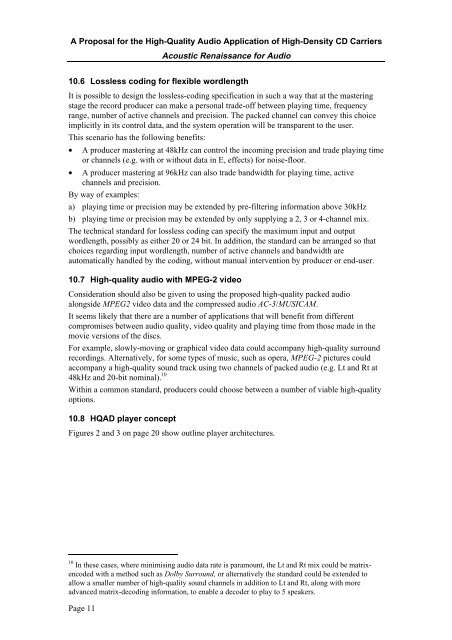A Proposal for the High-Quality Audio Application of High ... - Meridian
A Proposal for the High-Quality Audio Application of High ... - Meridian
A Proposal for the High-Quality Audio Application of High ... - Meridian
Create successful ePaper yourself
Turn your PDF publications into a flip-book with our unique Google optimized e-Paper software.
A <strong>Proposal</strong> <strong>for</strong> <strong>the</strong> <strong>High</strong>-<strong>Quality</strong> <strong>Audio</strong> <strong>Application</strong> <strong>of</strong> <strong>High</strong>-Density CD Carriers<br />
Page 11<br />
Acoustic Renaissance <strong>for</strong> <strong>Audio</strong><br />
10.6 Lossless coding <strong>for</strong> flexible wordlength<br />
It is possible to design <strong>the</strong> lossless-coding specification in such a way that at <strong>the</strong> mastering<br />
stage <strong>the</strong> record producer can make a personal trade-<strong>of</strong>f between playing time, frequency<br />
range, number <strong>of</strong> active channels and precision. The packed channel can convey this choice<br />
implicitly in its control data, and <strong>the</strong> system operation will be transparent to <strong>the</strong> user.<br />
This scenario has <strong>the</strong> following benefits:<br />
• A producer mastering at 48kHz can control <strong>the</strong> incoming precision and trade playing time<br />
or channels (e.g. with or without data in E, effects) <strong>for</strong> noise-floor.<br />
• A producer mastering at 96kHz can also trade bandwidth <strong>for</strong> playing time, active<br />
channels and precision.<br />
By way <strong>of</strong> examples:<br />
a) playing time or precision may be extended by pre-filtering in<strong>for</strong>mation above 30kHz<br />
b) playing time or precision may be extended by only supplying a 2, 3 or 4-channel mix.<br />
The technical standard <strong>for</strong> lossless coding can specify <strong>the</strong> maximum input and output<br />
wordlength, possibly as ei<strong>the</strong>r 20 or 24 bit. In addition, <strong>the</strong> standard can be arranged so that<br />
choices regarding input wordlength, number <strong>of</strong> active channels and bandwidth are<br />
automatically handled by <strong>the</strong> coding, without manual intervention by producer or end-user.<br />
10.7 <strong>High</strong>-quality audio with MPEG-2 video<br />
Consideration should also be given to using <strong>the</strong> proposed high-quality packed audio<br />
alongside MPEG2 video data and <strong>the</strong> compressed audio AC-3/MUSICAM.<br />
It seems likely that <strong>the</strong>re are a number <strong>of</strong> applications that will benefit from different<br />
compromises between audio quality, video quality and playing time from those made in <strong>the</strong><br />
movie versions <strong>of</strong> <strong>the</strong> discs.<br />
For example, slowly-moving or graphical video data could accompany high-quality surround<br />
recordings. Alternatively, <strong>for</strong> some types <strong>of</strong> music, such as opera, MPEG-2 pictures could<br />
accompany a high-quality sound track using two channels <strong>of</strong> packed audio (e.g. Lt and Rt at<br />
48kHz and 20-bit nominal). 10<br />
Within a common standard, producers could choose between a number <strong>of</strong> viable high-quality<br />
options.<br />
10.8 HQAD player concept<br />
Figures 2 and 3 on page 20 show outline player architectures.<br />
10 In <strong>the</strong>se cases, where minimising audio data rate is paramount, <strong>the</strong> Lt and Rt mix could be matrixencoded<br />
with a method such as Dolby Surround, or alternatively <strong>the</strong> standard could be extended to<br />
allow a smaller number <strong>of</strong> high-quality sound channels in addition to Lt and Rt, along with more<br />
advanced matrix-decoding in<strong>for</strong>mation, to enable a decoder to play to 5 speakers.


